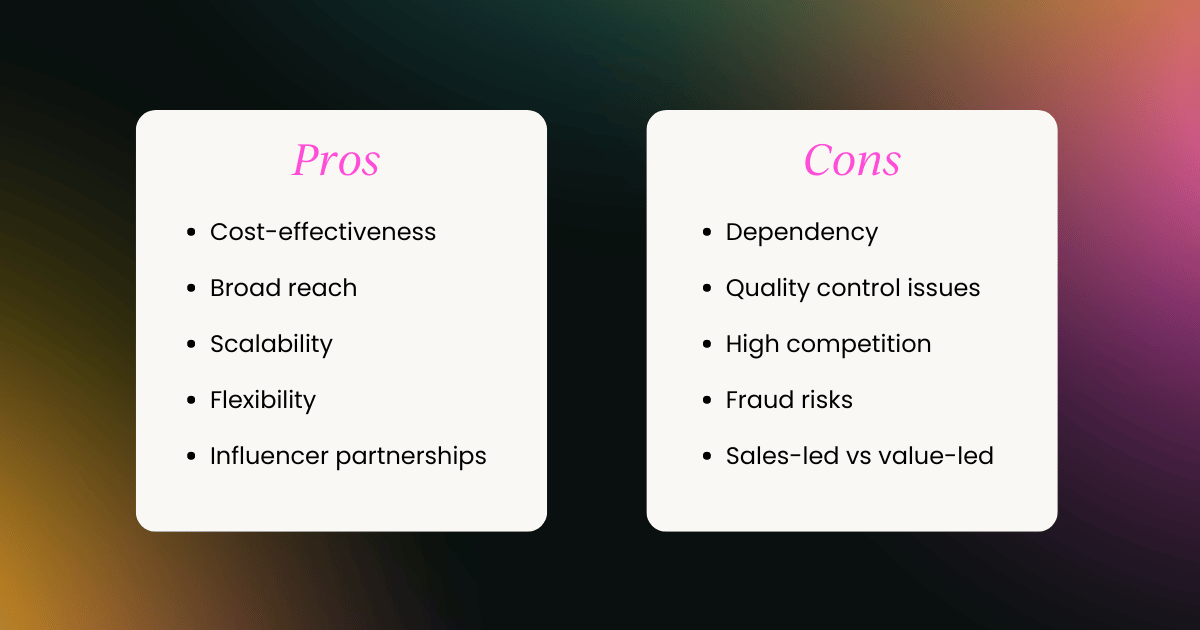As with all marketing strategies, it’s always worth learning as much about them as possible before implementing them into your wide marketing plan. Many marketing strategies will be more or less suited to your way of working depending on your team and organization's priorities.
Affiliate marketing is just one of many paths to explore when building a strong and sustainable customer marketing strategy.
In this article we’ll be covering:
- What affiliate marketing is,
- How the rise of influencers has changed affiliate marketing,
- The pros of affiliate marketing, and
- The cons of affiliate marketing.
Let's get going.
What is affiliate marketing?
Affiliate marketing is a performance-based marketing strategy where a business rewards one or more affiliates for each visitor or customer brought by the affiliate's own marketing efforts.
Essentially, it involves three key parties: the merchant (or advertiser), the affiliate (or publisher), and the customer:
- Merchant: Also known as you! The creator, seller, brand, or vendor is the party that creates the products or services.
- Affiliate: This is the individual or a company that will promote your products or services. Typically, they’ll be chosen based on the success of their platform—such as a blog, social media account, or website—to direct their audience to your product using a unique affiliate link.
- Customer: The customer is the final link in this chain. When they purchase the product or service through the affiliate link, the affiliate will typically earn a commission from the merchant.
Affiliate marketing shares the revenues between the merchant and the affiliate. The commissions given to your affiliate will typically be earned based on performance, which might include actions such as sales, clicks, or registrations.
Affiliate marketing leverages individuals to represent the face of your business and products, and as such will help to make sales based on the relationship your affiliate has with your customers. The strategy has evolved particularly with the rise of social media influencers.
Types of affiliate marketing models
Looking into how affiliates get compensated, there are a few different ways that are commonly used. As with everything, this will depend on your unique relationship with your affiliate, and the strengths that specifically support your business model:
- Pay-Per-Sale (PPS): This is the most common type. In this arrangement, the affiliate earns a percentage of the sale price of the product or service they’ve promoted after a consumer purchases it through the affiliate link.
- Pay-Per-Click (PPC): Affiliates are paid based on the number of visitors they redirect to the merchant’s website from their affiliate site, regardless of whether a sale is made.
- Pay-Per-Lead (PPL): Affiliates get paid based on the conversion of leads. The affiliate must persuade the consumer to visit the merchant’s website and complete the desired action, whether it’s filling out a contact form, signing up for a trial of a product, subscribing to a newsletter, or downloading software or files.
- Pay-Per-Install (PPI): This model is often used in the software industry where affiliates earn a commission each time the software is downloaded and installed by users through their links.
- Pay-Per-View (PPV)/Cost-Per-View (CPV): Affiliates are compensated according to how many views or interactions an advertisement receives. This model is commonly used in campaigns focusing on brand exposure.
- Two-tier: Affiliates earn commissions on a direct sale or referral action on their own site, plus a secondary commission if another affiliate (that they recruited) also generates a sale or referral.
- Residual earnings: Affiliates continue earning money after the initial sale, provided the customer continues to pay for the subscribed service or product. This model is common with memberships and subscriptions.
- Lifetime commissions: Similar to residual earnings, this model allows affiliates to continue earning a commission from a client whenever the client makes purchases in the future, often for as long as the client remains with the service.
Each model has its advantages and is suitable for different types of products, target audiences, and affiliate strengths. Choosing the right model depends on the specific goals and strategies of the affiliate and the merchant.

The evolution of affiliate marketing
Origins of affiliate marketing
While affiliate marketing has existed in some form or another since the 1980s, the first acknowledged program was launched in 1994 by William J. Tobin, the founder of PC Flowers & Gifts. This program used the internet to track affiliate sales, and Tobin patented the concept in 1996.
This style of marketing flourished over the years but truly exploded in popularity with Amazon’s affiliate program in 1996. This program allowed bloggers and website owners to link to any Amazon product and earn a commission on resulting sales.
This affiliate program is still going strong today – you see it a lot now from social media influencers, who have their own Amazon affiliate pages with unique links to sometimes hundreds of different products.

With the evolution of internet search engings, search engine optimization (SEO) and pay-per-click (PPC) advertising became crucial strategies for affiliates. The rise of Google as a dominant search engine prompted affiliates to optimize their websites and ads to rank higher in search results, driving more traffic and sales.
But there is a caveat. With recent Google updates, some styles of affiliate marketing have taken a hit, specifically in the form of written content. With the rise of AI tools like ChatGPT, Google has been working hard to counter the influx of low value AI written content.

One Reddit user wrote about their own affiliate marketing story and the issues they face with the more recent Google updates. They speak about how they wrote a few simple how-to articles that skyrocketed to No.1 on Google for their chosen keywords but that they didn’t write for value to their readers:
“I wrote some very simple and basic articles and included how-to and FAQ snippets on all of them. On the how-to guides, I did not even have step-by-step images or videos...The content would be thin and aimed at converting the affiliate links. Most people would skim the blog, click one in the top 3, and purchase it. A gold mine that deserved to run dry!”
But with Google’s more recent updates, adding in FAQs and topical headers was no longer enough:

With AI on the rise, the industry is seeing a push towards transparency and ethical practices; consumers are becoming more aware of affiliate marketing schemes and demand more authenticity from influencers and content creators. With Google’s support on this front, what are the pros and cons of affiliate marketing within this developing content marketing landscape.

Pros of affiliate marketing
First things first, let’s look into the pros of affiliate marketing:
- Cost-effectiveness: Only pay for performance (e.g., conversions, clicks).
- Broad reach: Ability to tap into a larger audience through affiliates' own networks.
- Scalability: Easy to scale up or down based on performance and budget.
- Flexibility: Various models to suit different marketing strategies and objectives.
- Influencer Partnerships: Leveraging influencer credibility and reach for targeted exposure.

Cons of affiliate marketing
But what about the cons?
Here are some common issues marketers face when utilizing affiliate marketing:
- Dependency: Over-reliance on third parties for revenue generation.
- Quality control issues: Potential misalignment of affiliate’s methods with brand values.
- High competition: Difficulty in distinguishing one's brand in a saturated market.
- Fraud risks: Vulnerability to fraudulent activities that can affect ROI.
- Complexity in tracking and attribution: Challenges in accurately tracking affiliate performance and attributing sales.
- Sales-led vs. value-led: Without being paired with value to customers, affiliate marketing can risk sounding like a plea for sales rather than a solution to customer needs.
How to conduct a value-led affiliate marketing strategy
So, how do you avoid the common pitfalls of affiliate marketing whilst still getting the benefits of its perks for your company? We’ve put a few of our favorite tactics to make affiliate marketing work for you in the current digital landscape:
- Choose the right affiliates: Partner with affiliates who genuinely resonate with the brand and its values. These should be individuals or companies whose audiences align with the business’s target demographic and who share a similar ethos. This alignment ensures that marketing feels authentic and builds trust.
- Make your affiliation know: Both affiliates and the businesses they represent should be transparent about the use of affiliate links. Consumers appreciate honesty, and disclosing affiliate relationships builds trust. Regulations in many regions require such disclosures, so adhering to these guidelines is both ethical and compliant.
- Focus on quality content: Encourage affiliates to create high-quality, engaging, and informative content that adds real value to the audience's experience. Whether it’s detailed reviews, tutorials, or creative storytelling, content that prioritizes the user’s needs can enhance engagement and drive conversions more effectively.
- Provide value to the consumer: Offer exclusives, discounts, or special promotions through affiliate links. This approach not only incentivizes purchases but also makes the deals more attractive to the audience, providing a clear benefit to following the affiliate link.
- Regularly monitor and feedback to your affiliate: Maintain an ongoing dialogue with affiliates to ensure their tactics remain aligned with the brand’s values and marketing goals. Regularly reviewing performance metrics also helps in understanding what works and what doesn’t, allowing for timely adjustments to strategies.
- Support your affiliates: Provide affiliates with the necessary tools, resources, and support to succeed. This includes access to up-to-date product information, samples for review, creative assets, and possibly training in best practices.
Customer references
Customer references are also a good use of customer content, and may be considered as more authentic than a poorly designed affiliate program.
In one episode, of our top podcast, Customer Marketing Catch-up, we talk to Collette Johnson, Product and Strategy Consultant, about customer references, their importance, and how they can be used. We also discuss some common mistakes and pitfalls that most clients fall into.
Listen to the full thing below. 👇






